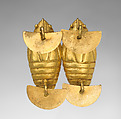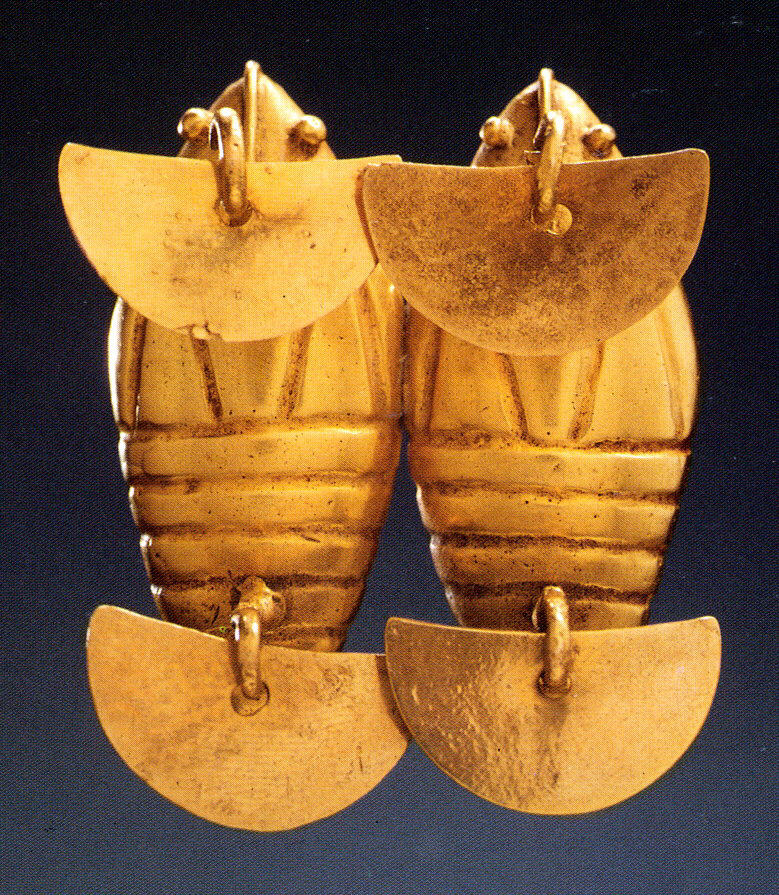Double Insect Pendant
Not on view
Displaying two insects at the pupa stage of their lives, between larvae and adults, this pendant was made by metalworkers in the middle Cauca Valley and Central Cordillera of Colombia. Their work was part of the Early Quimbaya tradition, which spanned from 300 B.C. to A.D. 700. "Quimbaya" refers to the people who lived on the eastern side of the Cauca River at least in the 16th century. In recent centuries, antiquarians and archaeologists expanded the name to encompass the production of materials, particularly metals in Early and Late phases, over this wider geographic area beginning around 300 B.C. (for more on the construction of the Quimbaya tradition, please see Metropolitan Museum of Art 1979.206.554). This pendant is notable for having four hooks and danglers or plaques that connect to the insects’ bodies. Metalworkers created the pendant through a combination of lost-wax casting and hammering. It is likely made of gold or a gold-copper alloy, that is, a chemical mixture of gold and copper.
Each insect’s head shows a pair of spherical eyes that protrude from the surface. A raised band of metal that divides the head in half continues over the top edge and onto the reverse. Most of the body of each insect shows linear motifs that suggest it is an exoskeleton or shell from which the insect emerges. Beneath the head, there are two horizontal linear depressions spaced well apart from each other. The midsection of each shell includes two pairs of vertical lines whose top ends angle inward.
Continuing down the shell, there are six horizontal lines that are spaced evenly and extend to the bottom tip of the pendant. Similar to the topmost lines, all of these lines appear as depressions in the metal. On each insect, a hook protrudes from just below the head and from the lower quarter of the body or shell. Each hook extends outward and ends in a circle. The circle is partially open, leaving space for the attachment of a dangler in the shape of a half-moon.
On the reverse of the pendant, the band from the front extends down the middle of each head before ending in a closed double circular loop. This loop may have enabled a person to suspend the object as a pendant or ornament. The remainder of the reverse side shows a cavity. Thus, the object is hollow and in the region of the cavity, it is possible to see the reverse of the linear decoration that appears on the front side.
Lost-wax casting was the primary means used to make this object (for more information on this process, please see Metropolitan Museum of Art 1974.271.48). Metalworkers shaped the insects and their shells first in wax. The horizontal and diagonal lines on the pendant were carved into the wax, while separate bits and threads of wax were added to form the eyes and vertical band on the head. The hooks on the front and the loops on the reverse also were designed in wax and likely cast with the rest of the pendant. The object was cast with an open back, and the ceramic core would have been located in the cavity that is now visible on each insect. To create the danglers, metalworkers hammered gold sheet to the current thinness of the danglers and chiseled out their shape. Finally, they made a circular perforation at the top center of each dangler so that it could be threaded onto the hook. Between its excavation and the present time, the pendant was highly polished, but some polishing may have taken place just after its fabrication, too.
On wearing the pendant, a person would see the insect heads facing them. When the danglers move, their bottom edges strike the insect bodies, producing light, high-pitched, and soft sounds. Overall, the dangler’s range of motion is not especially wide. These attributes of the pendant raise questions over its role: perhaps it was meant to be heard in an intimate space, or even only by the person wearing it. Perhaps the presence of hooks and danglers—even if they did not move to strike the body—made the object capable of producing sounds or motion in ways that cannot be understood by outsiders. Like the danglers on a Quimbaya bird pendant (1979.206.736) or the poporo or lime container from Puerto Nare (Museo del Oro, Bogotá O032852) (see Museo del Oro, Banco de la República 2007, 132-33), the danglers on the present pendant conceal some of the surface. If people valued the visibility of the insects, which themselves are partially hidden in their shells, then the preference may have been for the object to move. In this case, the danglers would reveal the surface when they moved. Alternatively, viewing the object in profile could reveal areas hidden by the still danglers. Simply put, visibility may have been only one component among sound, motion, and all of these features acting together, which affected people’s interaction with the object.
Numerous examples of Quimbaya goldwork involve representations of animals, including insects, such as butterflies, or gastropods, such as snails (Plazas 2016, 270). One pendant (Museo del Oro, Bogotá O00089) from the site of Corinto in the middle Cauca Valley shows an insect at the pupa stage almost completely enclosed by its shell (see Museo del Oro, Banco de la República, 100-01; Pérez de Barradas 1965, pl. 25; 1966, 32-33). In this case, the shell features the ridged horizontal quality of the present example and also includes a band decorated with diagonal lines. While the pendant in the Metropolitan incorporates two loops on the reverse, this example includes two perforations that may have been used for suspension.
In Quimbaya metalworking, importance is often placed on pairs of animals. Similar to the example in the Metropolitan, another pendant from the department of Quindío or Caldas (see Pérez de Barradas 1965, pl. 62, top left) shows two insects emerging from their shells. In this case, a short bar connects their bodies. Other Quimbaya objects feature double birds joined by short bars (Dumbarton Oaks PC.B.396) with hooks and danglers on their bodies.
Some objects like the present example focus on a particular stage of these insects’ lives, before they become adults and fully break out of their pupal shells. This choice may relate to the larger theme of fertility in Quimbaya goldwork (see Uribe 2005). Other objects may depict women who are pregnant, or show different fruits, such as calabazos, calabazas, or totumas. Expanding the theme of generational transitions, some Quimbaya gold objects also acted as containers for cremated human remains (Plazas 2016, 274-75).
Embedded within some Indigenous communities in present-day Colombia, there are deep associations between gold and fertility that persist through oral traditions. For instance, farther south along the Cauca River, Guambiano communities refer to their territory as Øskøwampik, "gold-colored land" (Muelas 2002). While gold in its mineral form is not common in the territory, much of the vegetation has a yellow color, and the land is good for cultivation. In this way, people may have involved the present pendant in a wider set of practices that linked gold and fertility. These practices included more intangible aspects (such as color, sound, and oral traditions) as well as organic aspects (insects, their shells, maize, calabazos, etc.) that exist within and beyond this pendant today.
Bryan Cockrell, Curatorial Fellow, Arts of Africa, Oceania, and the Americas, 2018
Related Objects: 1974.271.48, 1979.206.534, 1979.206.554, 1979.206.736, 1995.481.6
Further reading
Muelas Hurtado, Bárbara. "Øskøwampik, tierra color del oro." Boletín Museo del Oro 50 (2002). https://publicaciones.banrepcultural.org/index.php/bmo/article/view/4865 (Jan. 10, 2018).
Museo del Oro, Banco de la República. The Art of Gold: The Legacy of Pre-Hispanic Colombia: Collection of the Gold Museum in Bogotá. México: Fondo de Cultura Económica, 2007.
———. Museo del Oro. Bogotá: Banco de la República, 2008.
Pérez de Barradas, José. Orfebrería prehispánica de Colombia: Estilos Quimbaya y otros: Láminas. Madrid, 1965.
———. Orfebrería prehispánica de Colombia: Estilos Quimbaya y otros: Texto. Madrid, 1966.
Plazas, Clemencia. "Inventario de orfebrería Quimbaya Clásico." In El tesoro Quimbaya, edited by Alicia Perea, Ana Verde Casanova, and Andrés Gutiérrez Usillos, 261-78. Madrid: Ministerio de Educación, Cultura y Deporte, 2016.
Uribe Villegas, María Alicia. "Mujeres, calabazos, brillo y tumbaga: Símbolos de vida y transformación en la orfebrería Quimbaya Temprana." Boletín de antropología Universidad de Antioquia 19, no. 36 (2005): 61-93.
Due to rights restrictions, this image cannot be enlarged, viewed at full screen, or downloaded.
This artwork is meant to be viewed from right to left. Scroll left to view more.




